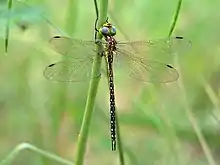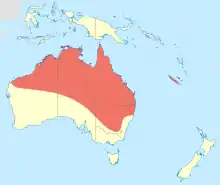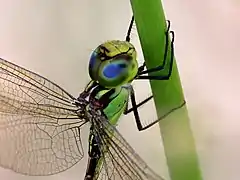| Australian duskhawker | |
|---|---|
 | |
| Male, Queensland | |
| Scientific classification | |
| Domain: | Eukaryota |
| Kingdom: | Animalia |
| Phylum: | Arthropoda |
| Class: | Insecta |
| Order: | Odonata |
| Infraorder: | Anisoptera |
| Family: | Aeshnidae |
| Genus: | Austrogynacantha Tillyard, 1908[2] |
| Species: | A. heterogena |
| Binomial name | |
| Austrogynacantha heterogena | |
 | |
Austrogynacantha is a genus of dragonfly in the family Aeshnidae.[4] Austrogynacantha heterogena, commonly known as the Australian duskhawker, is the only known species of this genus[5] which is found in Australia[6] and New Caledonia.[7]
Austrogynacantha heterogena is a medium-sized dragonfly, darkly coloured with bright green or yellow markings. It is a vagrant, is active at dawn and dusk,[6] and inhabits still waters.[8]
Gallery
 Close-up of head
Close-up of head.jpg.webp) Female Austrogynacantha heterogena wings
Female Austrogynacantha heterogena wings.jpg.webp) Male Austrogynacantha heterogena wings
Male Austrogynacantha heterogena wings
Note
The Australian duskhawker, Austrogynacantha heterogena, should not be confused with almost-similarly named Australasian duskhawker, Anaciaeschna jaspidea, a different species of Aeshnid dragonfly.
References
Wikimedia Commons has media related to Austrogynacantha.
Wikispecies has information related to Austrogynacantha.
- ↑ Dow, R.A. (2017). "Austrogynacantha heterogena". IUCN Red List of Threatened Species. 2017: e.T14254997A14255005. doi:10.2305/IUCN.UK.2017-1.RLTS.T14254997A14255005.en. Retrieved 20 November 2021.
- ↑ Tillyard, R.J. (1908). "On the new genus Austrogynacantha (Neuroptera: Odonata) with description of species". Proceedings of the Linnean Society of New South Wales. 33: 423–431 [425] – via Biodiversity Heritage Library.
- ↑ Tillyard, R.J. (1908). "On the new genus Austrogynacantha (Neuroptera: Odonata) with description of species". Proceedings of the Linnean Society of New South Wales. 33: 423–431 [428] – via Biodiversity Heritage Library.
- ↑ "Genus Austrogynacantha Tillyard, 1908". Australian Faunal Directory. Australian Biological Resources Study. 2012. Retrieved 10 February 2017.
- ↑ Schorr, Martin; Paulson, Dennis. "World Odonata List". Slater Museum of Natural History. University of Puget Sound. Retrieved 20 March 2017.
- 1 2 Theischinger, Günther; Hawking, John (2006). The Complete Field Guide to Dragonflies of Australia. Collingwood, Victoria, Australia: CSIRO Publishing. p. 148. ISBN 978 0 64309 073 6.
- ↑ Watson, J.A.L.; Theischinger, G.; Abbey, H.M. (1991). The Australian Dragonflies: A Guide to the Identification, Distributions and Habitats of Australian Odonata. Melbourne: CSIRO. pp. 278 [186]. ISBN 978-0643051362.
- ↑ Theischinger, Gunther; Endersby, Ian (2009). Identification Guide to the Australian Odonata. Department of Environment, Climate Change and Water NSW. p. 204. ISBN 978 1 74232 475 3.
This article is issued from Wikipedia. The text is licensed under Creative Commons - Attribution - Sharealike. Additional terms may apply for the media files.
